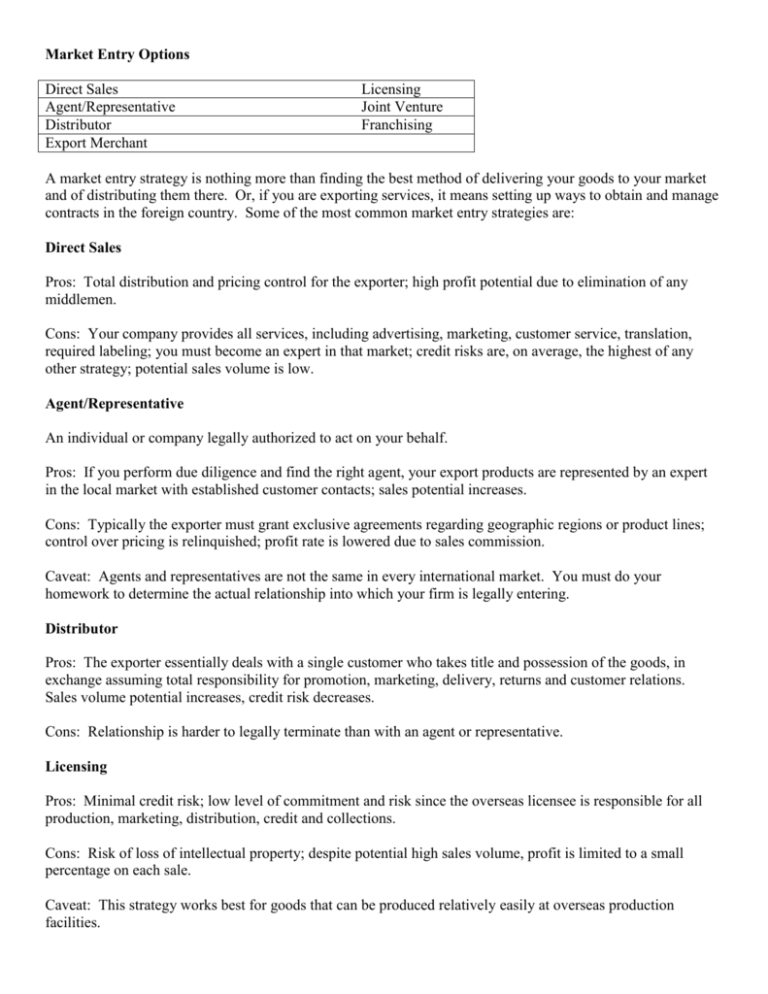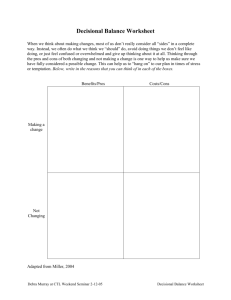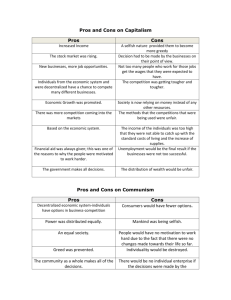Market Entry Checklists
advertisement

Market Entry Options Direct Sales Agent/Representative Distributor Export Merchant Licensing Joint Venture Franchising A market entry strategy is nothing more than finding the best method of delivering your goods to your market and of distributing them there. Or, if you are exporting services, it means setting up ways to obtain and manage contracts in the foreign country. Some of the most common market entry strategies are: Direct Sales Pros: Total distribution and pricing control for the exporter; high profit potential due to elimination of any middlemen. Cons: Your company provides all services, including advertising, marketing, customer service, translation, required labeling; you must become an expert in that market; credit risks are, on average, the highest of any other strategy; potential sales volume is low. Agent/Representative An individual or company legally authorized to act on your behalf. Pros: If you perform due diligence and find the right agent, your export products are represented by an expert in the local market with established customer contacts; sales potential increases. Cons: Typically the exporter must grant exclusive agreements regarding geographic regions or product lines; control over pricing is relinquished; profit rate is lowered due to sales commission. Caveat: Agents and representatives are not the same in every international market. You must do your homework to determine the actual relationship into which your firm is legally entering. Distributor Pros: The exporter essentially deals with a single customer who takes title and possession of the goods, in exchange assuming total responsibility for promotion, marketing, delivery, returns and customer relations. Sales volume potential increases, credit risk decreases. Cons: Relationship is harder to legally terminate than with an agent or representative. Licensing Pros: Minimal credit risk; low level of commitment and risk since the overseas licensee is responsible for all production, marketing, distribution, credit and collections. Cons: Risk of loss of intellectual property; despite potential high sales volume, profit is limited to a small percentage on each sale. Caveat: This strategy works best for goods that can be produced relatively easily at overseas production facilities. Joint Venture Pros: Per unit cost of production can be significantly lowered by moving selected manufacturing overseas; higher sales volume, market penetration and profit potential than any other strategy. Cons: High level of commitment, investment, resource allocation and risk. Caveat: This high risk, high commitment, but potentially high reward strategy is for exporters already experienced in the target market who are prepared to go the full nine yards to take maximum advantage of that market's potential. Franchising Pros: Wide market coverage, quick market coverage; protection from copying and reasonably profitable. Cons: High cost of studying laws and regulations in different countries; cost of frequent visits to support franchisees and potential to lose contract to major franchisee. Caveat: Franchising your idea, product and style of presentation to foreign franchisees carries with it a moderate degree of risk. Export Merchant Pros: All financial and legal matters handled in home country; relieves burden of risk. Cons: You will never learn about exporting; there will be no input into marketing decision; there will be scant feedback on product performance for future R&D.






